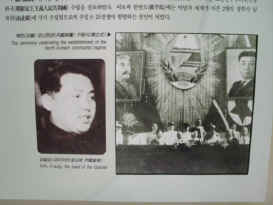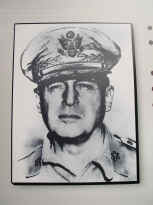|

The Korean War

Under such circumstances early on the Sunday morning of June
25, 1950, without any warning or declaration of war, North Korean troops invaded
the unprepared South across 38th parallel. It was a well-prepared, all-out
attack. South Korea's troops fought bravely, but proved no match for the heavily
armed Communists and the Russian T-3 tanks, who were not checked until they
reached the Naktonggang river near Taegu.
The Republic of Korea appealed to the United Nations. In
response, the Security Council passed a resolution ordering the Communists to
withdraw to the 38th parallel and encouraged all member countries to give
military support to the Republic. U.S. troops soon began to arrive, and were
subsequently 1joined by those from 15 other nations: Australia, New Zealand,
Britain, France, Canada, South Africa, Turkey, Thailand, Greece, the
Netherlands, Ethiopia, Colombia, the Philippines, Belgium, and Luxemburg. The
three Scandinavian countries sent hospitals along with medical personnel.
Under the command of Gen. Douglas MacArthur, the Allied forces
began to take the initiative, and after a surprise landing at Inch'aon,
pushed the Communists out of South Korea and advanced into the North.
But in October the Communist Chinese intervened, throwing such
large numbers of troops into battle that the U.N. forces were forced to retreat.
Seoul once again fell into Communist hands on January 4, 1951. The U.N. forces
regrouped and mounted a counterattack, retaking Seoul on March 12. A stalemate
was reached roughly in the area along the 38th parallel, where the conflict had
begun.
At this point the Soviet Union called for truce negotiations,
which finally began at Kaesong in July of 1951, and
were transferred to P'anmunjom in November that
year. The talks dragged on for two years before an armistice agreement was
reached on July 27, 1953.
Back to Top

Democratic Revolution
In the aftermath of the Korean War, the country was beset with
many problems - economic, social and political. The old patriot, Syngman Rhee,
unable to see that he had outlived his usefulness, clung tenaciously to power.
This refusal on the part of Rhee and his associates to let democratic processes
take their normal course was at least partly responsible for the social and
political unrest that followed the war.
Social disorder and hostility to the government complicated
the already staggering problems created by the war. There were many thousands of
war widows, more than 100,000 orphans, and tens of thousands of unemployed,
whose ranks were swelled by farmers leaving their land to seek work in the
cities. Exact statistics are not available, but in 1961 it was estimated that
there were about 279,000 unemployed, of whom 72,000 were university graduates,
and 51,000 discharged soldiers and laid-off workers. This provided a powder keg
of anger and resentment that waited only for a spark to set it off.
The spark was provided by President Rhee and the Liberal Party
in the course of the elections of 1960. Realizing its own unpopularity, the
ruling regime used every means, legal or illegal, to rig the elections in its
favor. Demonstrations broke out almost at once, especially among students.
Protesting against government interference in schools, students rose up in Taegu
on February 28, 1960. On March 15, election day, students demonstrated against
the election, and police subsequently fired into the crowds. In early April, the
discovery at Masan of the body of a student who had been killed by police was
followed by a riot.
The most serious demonstrations were in Seoul. Responding to
the Masan affair, practically all of the students in the capital poured into the
streets. Again police fired on them as they neared the presidential residence
and there was bloodshed. Martial law was imposed and troops dispersed the
crowds.
Rhee had no choice but to step down. His desire for power had
overcome his patriotism in the end. The students had led the people into the
first successful democratic revolution in Korea's history, showing that Korean
democracy was alive and healthy.
On July 15, 1960, an amendment to the Constitution was adopted
by the incumbent Assembly providing for a cabinet system of government with a
bicameral legislature. At the same time, the two houses of the newly elected
Assembly in a joint session elected Yun Po-sun President of the Second Republic,
and he was sworn in on August 15. President Yun nominated Dr. Chang Myon (John
M. Chang) as Prime Minister, whose nomination was promptly confirmed by the
House of Representatives. At this time, the Liberal Party was replaced by the
Democratic Party as the majority party, and it immediately split into the New
Democrats and the (Old) Democrats. The Prime Minister belonged to the former
while the President belonged to the latter. Neither was strong enough
constitutionally or personally to fill the gap created by the sudden ouster of
the 12-year-old autocratic rule of President Syngman Rhee.
The new government was unable to cope with the situation in
which it found itself. For one thing, most members of the new cabinet, while
without question honest people, had little experience in government. The
leaders, tasting the long-denied fruits of political power, began to wallow in
its corrupting effect. The national economy had been brought to the brink of
bankruptcy due to unfair tax collection practices coupled with waste and
mismanagement of foreign aid and domestic resources under the Rhee
administration. Prime Minister Chang's cabinet not only failed to muster the
united support of the populace to cope with such problems, but helplessly stood
by and watched daily demonstrations by students who thought they could sway
national affairs by parading in the streets.
The North Korean Communists, having recovered from their
disastrous adventure of 1950-1953, seized the opportunity of internal disorder
in the South to subvert whatever effort the Chang administration could put
forth. Elements of doubtful allegiance began urging "Peaceful
Unification," a familiar line of propaganda emanating from Radio P'yongyang
daily at that time.
Korea's
Main Page
Seoul's
Main Page
Summary of Korean History
|








